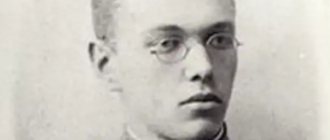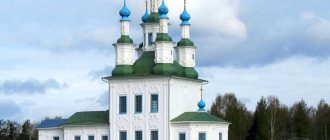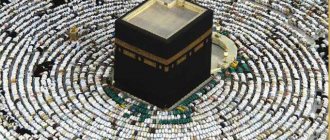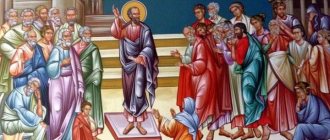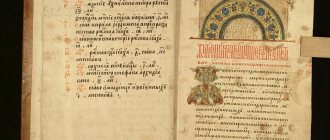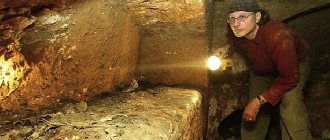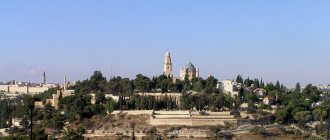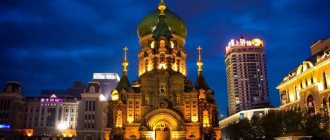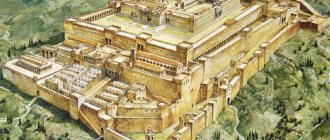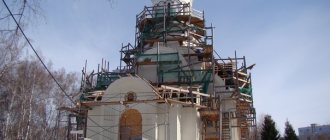| Jerusalem Trinity Cathedral of the Russian Metochion |
| Ascension Cathedral of the Olivet Monastery |
Russian spiritual mission in Jerusalem
, two parallel canonical formations of the Russian Orthodox Church in the Holy Land - under the direct authority of the Patriarch of Moscow and All Russia and as part of the Russian Orthodox Church Outside of Russia
- Mission Directorate:
- Patriarchal: Israel, Jerusalem. Russian Ecclesiastical Mission in Jerusalem, Russian Compound, 6 Kheshin str., POBox 1042, Jerusalem 91009, Israel
- Foreign: Israel, Jerusalem. Russian Ecclesiastical Mission, PO Box 20164, Jerusalem 91200, Israel
- Patriarchal: (10-972-2) 625-25-65, fax: 625-63-25
- Patriarchal:
- Foreign:
The patriarchal mission is now primarily the representation of the Russian Orthodox Church under the Patriarch of Jerusalem and the state structures of Israel, the Palestinian Authority and Jordan.
Also a center for pastoral care for Russian-speaking Orthodox believers on the territory of these states and the leading pilgrimage service of the Russian Church for organizing trips to these lands and also to Egypt. The mission of the Russian Church Abroad also cares for pilgrims and supports the spiritual and material heritage of the Russian Church in the Holy Land.
Base
The question of establishing a representative office of the Russian Church in Jerusalem first arose in the 19th century, in connection with the difficulties experienced by pilgrims from Russia. The rector of the Moscow Jerusalem Metochion, Archimandrite Arseny, wrote to Emperor Alexander I in 1816: “ In Jerusalem, no one suffers so much poverty and the need for food and clothing and shelter itself, as Russian fans
" [1].
In 1838, the chamberlain of the imperial court, A. N. Muravyov, who visited Palestine to study the state of political and church life in the Holy Land and help strengthen Russia’s position in the Middle East, also raised the question of the need to establish a spiritual mission in Jerusalem. According to his thoughts, the Russian emperor should have become the patron of holy places, and the Russian archimandrite in Palestine “ could have a beneficial influence on ... fellow believers and spread light and necessary knowledge among them
[2].” In 1842, in a report addressed to the emperor, Vice-Chancellor Nesselrode noted the need for a clergyman to establish contacts with the local Greek clergy and mediate between the Jerusalem Patriarchate and the Russian Synod. It was also proposed to entrust such a cleric with control over the expenditure of donations collected in Russia for the Orthodox Church in the Holy Land.
In July 1842, the Synod decided to send Archimandrite Porfiry (Uspensky) to Jerusalem as an unofficial person. After meetings with the Patriarchs of Jerusalem, Constantinople and Antioch, he arrived in Jerusalem on December 20, 1843. After familiarizing himself with the situation, in his report to the Synod he spoke in favor of the creation of a spiritual mission, which would become a sign of “ visible unity of the churches of Jerusalem, Antioch and Russia
,” carried out missionary activities, helped set up schools and seminaries, and took care of Russian pilgrims [3].
In February 1847, Emperor Nicholas I approved the founding of the Russian Ecclesiastical Mission in Jerusalem. Archimandrite Porfiry (Uspensky) took the lead, and with him the hieromonk and future saint Theophan (Govorov) went to Jerusalem. The Patriarchate of Jerusalem allocated the Jerusalem Archangel Monastery to house them - there, for the first time in the Holy Land, services began to be performed in Slavic. In 1852, at the request of Patriarch Kirill of Jerusalem, Father Porfiry became a trustee of Orthodox public schools in Palestine and the highest Patriarchal school for the Greek clergy at the Jerusalem Cross Monastery. Archimandrite Porfiry also petitioned for the translation and publication of spiritual books in Arabic [4], and for improving the life of Russian pilgrims. Thanks to this, an Arabic printing house was opened at the Jerusalem Patriarchal See, and the Patriarchate allocated the Feodorov and Catherine monasteries in Jerusalem to accommodate Russian pilgrims [5]. Archimandrite Porfiry and his assistants devoted a lot of time to scientific works, research of church life and the history of the Christian East. The Crimean War in 1853-1856 forced the mission to temporarily cease its activities.
Growth and flourishing
After the war, the spiritual mission resumed. Under the leadership of Bishop Kirill (Naumov), the mission mainly began to provide assistance to the local Arab clergy and their flock, which was bribed by Western missionaries. An Orthodox church began to be built with Russian funds in the Arab village of Beit Sahur near Bethlehem. In Syria, Bishop Kirill established schools and sent spiritual literature and church utensils. Thanks to his assistance, the Syrian Uniates returned to the fold of the Orthodox Church. The concern for Russian pilgrims was not abandoned either - services were performed for them in their native language, religious services were performed, housing was rented, a small hospital was opened, and pilgrimage caravans were organized.
In 1857-1860, several plots of land were acquired near the walls of the Old City in Meidam Square in Jerusalem. They were purchased as the property of the imperial government through the efforts of the head of the mission and the Russian consuls, and then the Palestine Committee under the Asian Department of the Ministry of Foreign Affairs of the Russian Empire, which was specially created to improve the needs of Russian pilgrims. The vast area, later known as the Russian Compound or “Moscobia,” began to be built up with buildings for receiving Russian pilgrims. First of all, construction began on the cathedral church in the name of the Holy Trinity, which was solemnly consecrated in 1872. At the same time, other structures began to be erected: the building of the Russian Ecclesiastical Mission with the Church of the Martyr Alexandra, the Elizabethan (male) and Mariinsky (female) courtyards for pilgrims, the Russian hospital, the house of the Russian consul. All these buildings were built in the period 1859-1864 and are surrounded by a stone wall. The Alexandrinsky Church, consecrated in 1864, became the first church in the Holy Land built by the Russians.
At that time, a number of new Russian institutions were established in the Holy Land, to which many of the original functions of the spiritual mission were transferred. In 1856, the agency of the Russian Society of Shipping and Trade was created in Jerusalem. In 1858, a Russian consulate was established in Jerusalem. The construction of buildings at the Russian Compound was carried out by the Palestine Committee of the Asian Department of the Ministry of Foreign Affairs, which existed in 1859-1864. The Palestine Commission operated from 1864 to 1889. In 1882, the Imperial Orthodox Palestine Society was opened, which actively engaged in temple building. The task of the spiritual mission itself was to maintain contacts with the local clergy, transfer donations coming from Russia to the Jerusalem Church and spiritually nourish pilgrims.
Almost thirty years under the leadership of Archimandrite Antonin (Kapustin) became a golden age for the mission. Coldness in relations with the Russian Consulate in Jerusalem and often misunderstanding on the part of the Synod forced Archimandrite Antonin to find a new area of activity for the mission - the acquisition and development of land plots outside of Jerusalem [6]. Despite the frequent “lack of money” [7], it was possible to acquire a large number of plots, many of which are the original places where the events described in the Holy Scriptures unfolded. The acquisition of land also had a missionary function and interfered with the activities of Roman Catholics and Protestants, who bought up holy places and built their institutions on them. Thus, plots were acquired in Hebron, with Mamre oak (1868); on Mount Olivet near the site of the Ascension of the Lord (1868-1889); in Ein Karem, in the “Gornaya”, at the meeting place of the Blessed Virgin Mary and the righteous Elizabeth (1871); in Jericho (1874); in Jaffa with the tomb of righteous Tabitha (1886); in Beit Jala; in Siloam; in Tiberias; in Anat. Due to the difficulties of registering purchase deeds, the plots were purchased in the name of the dragoman of the mission, a Turkish citizen Ya. E. Halebi, who re-registered the deed of gift in the name of Archimandrite Antonin, and the head of the mission in 1894 bequeathed them to the Russian Church represented by the Holy Synod. In 1889, the total cost of the newly acquired plots was one million rubles [5]. During his lifetime, the purchase of land was often perceived with great coldness; in 1872, the Synod even ordered that further land acquisitions be abandoned.
Meanwhile, the construction of the sites was underway. Eleon was intended for a monastery - the Cathedral of Christ the Savior and a bell tower, called the “Russian Candle,” were erected here. In Gornaya (Ein Karem) a women's community was formed in which the Kazan Church was consecrated in 1883. An orange garden was established in Jaffa, a house for pilgrims was erected, and in 1894 the Church of the Apostle Peter was consecrated. A courtyard was built in Jericho for pilgrims traveling to the Jordan.
As before, the mission performed divine services and services for pilgrims, sometimes monastic tonsures, and during the pilgrimage period - readings and conversations with people, accompanying pilgrims. Efforts to educate the local population also continued - for example, with the funds of Empress Maria Alexandrovna, Archimandrite Antonin, on his own initiative, opened a school for girls in the Arab village of Beit Jala near Bethlehem. At the expense of his rest, Archimandrite Antonin found time for serious scientific studies in church archeology and Byzantine studies. He also created the Mission Archaeological Museum in Jerusalem.
The activities of the mission continued to expand in the given direction under the successors of Father Antonin, at the turn of the 19th century. New plots were acquired - in Haifa on Mount Carmel (1908); on the coast of the Sea of Galilee with the source of St. Mary Magdalene (1908; in Cana of Galilee; in Nazareth; in other places of the Holy Land. In 1907, construction of the Church of the Holy Forefathers began in Hebron, in 1910 the construction of the cathedral of the Gornensky Monastery began, and in 1913 The Church of the Holy Prophet Elijah was consecrated on Mount Carmel, as archaeological research had been conducted before.
In 1914, World War I interrupted the mission's activities, forcing the director and staff to move to Alexandria. The churches were closed, the premises were occupied by Turkish soldiers, and the expelled sisters and pilgrims who remained in the Holy City were subjected to oppression. Only at the end of the World War, during the Russian Civil War, was the mission able to begin to restore devastated life.
Interwar years
In 1919, after the occupation of Palestine by Great Britain, Russian monks returned to Jerusalem. Communication with Russia was severed, and from 1920 the mission came under the jurisdiction of the Provisional Higher Church Administration Abroad. The mission was deprived of the protection of any state, and most of the previous sources of material assistance disappeared. With the establishment of the British Mandate, most of the empty Russian Compound was occupied by civilian institutions - a police station, a prison, an American Red Cross branch, and then a supreme court. Many mission buildings were damaged and neglected.
Great assistance in maintaining the mission was provided by Archbishop Anastasius (Gribanovsky) of Chisinau, who was sent to the Holy Land by the foreign Russian hierarchy in 1921 and from 1924 served as overseer of the affairs of the mission for about ten years. First of all, the rights of the mission were recognized by the British authorities, and correct monastic life was restored. The Bishop put in order the property affairs of the Russian Spiritual Mission by leasing some plots and erecting several buildings with the help of loans. The Gethsemane monastery was opened, the Bethany school was founded, and a plot of land near the Jordan River was acquired. A period of new upheavals and changes in life followed the Second World War.
Division of mission
In 1945, Patriarch Alexy I of Moscow visited the Holy Land, and the question of canonical subordination to the mission arose. The Arab-Israeli War of 1947-1949 led to the formation of the State of Israel, which in 1948 transferred to the Moscow Patriarchate those churches and monasteries of the mission that were on its territory. The mission property that ended up on the territory of Jordan remained under the jurisdiction of the Church Abroad.
The Patriarchal Mission had to endure considerable difficulties in connection with the sale by the Soviet government of most of the Russian metochion to the state of Israel. However, liturgical life was maintained. In 1962, a temple was built in honor of St. Mary Magdalene on the shores of Lake Galilee. In 1987, construction of a cave church in honor of John the Baptist was completed at the Gornensky Monastery.
Since the late 1940s, the mission of the Church Abroad has managed to draw the attention of the Russian emigration to its plight and attract an influx of donations. The mission office was established first in Gethsemane and then in the Monastery of Olives. A plot was acquired in Wadi Faran where in ancient times the Lavra of St. Chariton was located. Under Archimandrite Anthony (Grabbe), control was transferred to Russian excavations near the Church of the Holy Sepulchre, but then moved again to the Monastery of Olives.
The Path to Revival and Reunification
The collapse of the USSR marked the beginning of an active revival of Palestinian pilgrimage among the Orthodox of the former union - the symbolic beginning was the pilgrimage of Patriarch Alexy II to the Holy Land in April 1991. Thanks to donations, large-scale restoration work began to be carried out at the patriarchal mission, and educational and publishing activities were resumed. In 1997, for the anniversary celebrations on the occasion of the 150th anniversary of the mission, Patriarch Alexy again arrived in Jerusalem, and the government of the Palestinian Authority transferred the monastery in Hebron to the mission. In 2000, Patriarch Alexy was again in the Holy Land to celebrate the 2000th anniversary of the Nativity of Christ - for this celebration, the mission built a large pilgrimage hotel complex on a purchased Russian site in Bethlehem, and the Palestinian authorities returned the compound in Jericho to the mission. In 2004, construction of the cathedral of the Gornensky Monastery was resumed. At the beginning of 2007, Jordan transferred to Russia a plot of land near the site of the Epiphany on the Jordan River for the construction of a pilgrimage compound.
Political pressure in the 1990s led to the fact that both properties transferred to the patriarchal mission - the Hebron Monastery and the Jericho Compound - were previously seized from the Church Abroad with the use of violence. Thanks to the restoration of canonical communion between the Domestic and Foreign parts of the Russian Orthodox Church in 2007, rapprochement began between the alienated Russian spiritual missions. In June 2007, the first joint divine service of representatives of both parts of the Russian Church took place in the Holy Land. By the early 2010s, the management of the Jericho Compound was carried out jointly by both missions.
Statistics
- January 1, 1965 - the foreign mission has 18 sites, 1 of which generated income; 16 monastics in the Mission (chief, acting assistant, housekeeper, 2 archimandrites, 2 hieromonks, 2 hierodeacons, schemamonk, monk, 2 monks of cassocks, 3 novices); 104 monks in the Olivet Monastery (53 nuns, 36 nuns, 15 novices); other monastics in the Bethany community, at the Oak of Mamre, in the Faran Lavra [8]
- 2000s - the patriarchal mission has 9 operating churches, 7 priests, 1 deacon [9]
History of the Russian Spiritual Mission in Jerusalem
The need to establish a representative office of the Russian Orthodox Church in Jerusalem was first discussed back in the 19th century. Then, in Palestine, Russian pilgrims were deprived of political protection. There were no priests in Israel, no schools to educate the flock. People did not have the opportunity to pray in their native language, not to mention normal everyday services and the fact that, after crossing the desert, many found themselves literally penniless. Throughout Europe and the Middle East, Orthodox Christians converted to Catholicism, and by the end of the century, all of Europe was Catholic. Orthodox holy places were under threat: they were simply sold to those who had a fat wallet. Thus, the churches gradually came under the control of the Turkish authorities.
In February 1847, Emperor Nicholas I, by his resolution, approved the founding of the Russian spiritual mission in Jerusalem. Archimandrite Porfiry (Uspensky), who had experience of staying and serving in the East, was appointed its first head. He had already visited the Holy Land and was familiar with the hardships of the Orthodox community, so after his appointment he immediately began actively engaging in educational activities.
The educational work of the spiritual mission has more than once been overshadowed by events that we still remember from history books. Thus, due to the fact that the Turkish authorities handed over the keys to the Church of the Nativity to representatives of the Catholic Church, the Crimean War broke out in 1853-1856. At the end of the war, the Mission’s activities were restored, an Orthodox church was built near Bethlehem, schools began to be founded and services were held in Russian.
Main Orthodox churches and monasteries of Jerusalem
Orthodox churches in Jerusalem are located mainly in the old city. This is not surprising, this is where the main shrines are concentrated. Shrines that appeared before the division of Christians have common churches or prayer buildings for believers of each denomination separately. But in any case, they are revered by all Christians together. The buildings, built after 1054, when the religion was divided into Orthodox and Catholic, have their own history. Here is a list of the main Orthodox churches in Jerusalem, which will be an excellent guide to the holy places.
Jerusalem means a lot to Christians around the world. That is why all Christian denominations have their representations here. However, not many Christians live in the city itself. Most believers, especially Orthodox Christians, live separately in Orthodox monasteries in Jerusalem, where they care for shrines, indulge in prayer and communicate with brothers and sisters in the faith. That is why there are quite a lot of Orthodox monasteries in Jerusalem. It is worth noting that the monasteries in Jerusalem differ significantly from Russian and Greek complexes. They do not have vast territories and economies. Monasteries can even be located in ordinary houses that belong to them, but they are wall to wall with the buildings of ordinary citizens.
Church of the Assumption of the Blessed Virgin Mary
The building is a crypt or grotto, the main part of which is underground. There are 48 steps leading to the temple. The room is created in the unusual shape of a cross, in which there is a cuvuklia or a small internal chapel. Here is the tomb of the Virgin Mary, in which there are no relics, since according to legend, the virgin ascended to heaven. The temple is visited mainly by women who pray for family well-being, easy birth and good health of children, traditional female happiness.
Gethsemane Convent
The convent named after Equal-to-the-Apostles Mary Magdalene was created in modern times, namely in 1934 next to the Orthodox church in Jerusalem. The building is located in the historical part of the Garden of Gethsemane. One of the monastery’s shrines is the cave chapel of the Lord’s Passion, built on the site of the apostles’ prayer for Jesus after his arrest. Most Orthodox churches and monasteries in Jerusalem carry the memory of historical moments in the life of Christ and are not only religious shrines, but also a huge cultural heritage.
Holy Trinity Church
The huge cathedral was built by the Russians in 1863. Services in the cathedral began only 9 years later in 1872. It was consecrated by the Orthodox Patriarch of Jerusalem Kirill II and a representative of the Russian Orthodox mission. It has a spacious room and a rich interior. The cathedral was built according to Russian canons.
Church of Mary Magdalene
The cathedral was built in the Russian style at the end of the 19th century in honor of the Great Empress Maria Alexandrovna. It bears the name of Equal-to-the-Apostles Mary Magdalene. The temple contains the relics of Mary Magdalene, the relics of the nun Varvara and the Grand Duchess Elizabeth Feodorovna. It is one of the most famous Orthodox churches in Jerusalem.
Church of St. George the Victorious
The temple is part of an ancient monastery, which no longer exists. The exact time of construction of the monastery is not known. The structure suffered several destructions, the building was often taken away by the Persians or Arabs. Today it is a modest church with a beautiful light, marble iconostasis in the old city.
Monastery of the Holy Cross
The oldest Orthodox monastery in Jerusalem, the time of its foundation is not precisely known. According to legend, on the site of this shrine grew a tree that was used to create a cross for the crucifixion of Jesus. The building resembles a fortress and is located on the territory of the New City.
Church of the Martyr Alexandra of Rome
A small house church, built in 1864 at the behest of Empress Alexandra Feodorovna, who was the wife of the Russian Tsar Nicholas I. The shrine bears the name of the queen’s heavenly patroness. The temple was also erected according to a special program of Russian buildings on the territory of Jerusalem.
Church of John the Baptist
The Church of John the Baptist is considered one of the oldest churches of the Orthodox Church. It was built back in the 5th century, then was destroyed and rebuilt. The building, modest on the outside, has a rich and colorful interior inside: a huge iconostasis, bright stained glass windows and a dome with luxurious frescoes. Such an interior will surprise any tourist, and will evoke a feeling of awe in a believer. Everyone who visits the temple should definitely take a photo of the luxurious decoration of the temple. Although the address of the temple is known, finding the entrance to it is not so easy: it is located between small shopping shops on Christian Street.
Church of the Holy Sepulcher
The most revered shrine of believers all over the world. Not only Christians, but Jews and Arabs treat her with great respect. The keys to this temple are kept by the Arab family, which has looked after the building for many generations. The structure was erected on the spot where Jesus Christ was crucified, buried nearby, and then resurrected. The place is worth visiting for anyone, regardless of religion. The temple has a special strong energy and atmosphere. The modern complex includes Golgotha or the site of the crucifixion of Christ, a burial place, the Church of St. Helena, several monasteries and monasteries.
The building is used by six Christian churches at once, one of which is Orthodox. Each denomination has separate areas where believers can pray and indulge in spiritual practices. Once a year, on Orthodox Easter, divine fire not made by hands descends here. This fire symbolizes the rebirth of Christ and new life. It is interesting that the first time after indulgence, the flame does not burn. Jerusalem candles burned by him are famous throughout the world. Lamps with fire and candles are distributed all over the world and are especially revered not only by Christians, but also by Muslims.
Pretoria Monastery
According to legend, the male Orthodox monastery of Pretoria is located on the site of the prison where Jesus was kept before his execution. The monastery is equipped with a prison of Jesus, which replicates the ancient structure. The building itself was built in the 18th century. Has several churches and limits for worship.
Gornensky Convent
The monastery was founded in 1871, but contains an ancient shrine - a stone on which, according to legend, John the Baptist preached. Unlike most monasteries in Jerusalem it has a vast territory. When this Orthodox monastery was founded in Jerusalem, the nuns had to build themselves separate houses to live in and plant an individual garden and vegetable garden. This tradition continues to this day.
Church of St. Alexander Nevsky
Another building built in the 19th century by the Imperial Russian Palestine Society. It was dedicated to Emperor Alexander III and bears the name of his spiritual patron Alexander Nevsky. The building has a historical relic: during the preparation of the foundation, the Threshold of the Gate of Judgment was discovered, through which Jesus passed when he stepped to his execution.
"Orange Deal"
In the 20th century, a turning point in the development of the Russian spiritual mission was the so-called “orange deal” of 1964, as a result of which a significant part of the lands with churches was sold to the USSR. During the period of cooling relations with Israel, the Soviet authorities decided to sell their property in the Holy Land, but practical Israelis did not want to buy churches that could not be used for other purposes. The Gornensky Monastery, where the nuns lived, also remained unsold. However, in the very center of Jerusalem, many historical buildings were sold, including the Elizabethan, Nikolaevskoe, Veniaminovskoe metochions and the French House.
This deal received the name “orange” because Israel paid the Soviet authorities for these lands with Jaffa oranges and textiles. Khrushchev, apparently, considered that the Soviet people needed, first of all, to eat and dress, and the spiritual heritage at that time had, in his opinion, the least priority.
Compound in the XX-XXI century
In the same year, the construction of the Sergievsky courtyard began at an accelerated pace, and later, in 1905, the Nikolaevsky one. All new buildings belonged to the Russian courtyard in Jerusalem. In 1964, all buildings (with the exception of the Trinity Cathedral and the Spiritual Mission) located on its territory were sold by the USSR government to the state of Israel. The deal was unofficially called “orange”, and its legality remains controversial to this day. Negotiations are regularly held to declare the transaction void and return all buildings to the Russian Orthodox Church.
In 2008, the building of the Sergievsky Compound, which was used by the Israeli Ministry of Agriculture, as well as an environmental organization, was returned to the ownership of the Russian Compound.
Renaissance
But the times of the USSR are left behind, and the Russian spiritual mission continues to serve in Israel to this day. In 1997, it celebrated its 150th anniversary. In connection with this event, His Holiness Patriarch Alexy II of Moscow and All Rus' visited the Holy Land. In 2000, he again arrived there on a visit to participate in the celebration of the 2000th anniversary of the Nativity of Christ. Representatives of all local Orthodox churches gathered for the big holiday.
In 2007, the Kingdom of Jordan transferred to the Russian Federation a plot of land near the site of the Epiphany on the Jordan River, where the Hospice House was established. And in the same year, representatives of the two united parts of the Russian Orthodox Church performed their first joint worship in the Holy Land.
Currently, the following temples and monasteries are under the jurisdiction of the Russian Spiritual Mission in Israel:
• Trinity Cathedral in Jerusalem;
• Temple in honor of the holy martyr Queen Alexandra (House Church of the RDM in Jerusalem);
• Gornensky Convent in Jerusalem;
• Compound with a temple in honor of the Holy Apostle Peter and Righteous Tabitha in Jaffa;
• Compound in honor of Equal-to-the-Apostles Mary Magdalene in Tiberias;
• Compound in honor of the Holy Forefathers in Hebron;
• Compound in honor of the holy prophet of God Elijah on Mount Carmel in Haifa;
• Metochion of St. John the Baptist in Jericho;
• Pilgrim's House in Tiberias (“House with Vaults” - hotel).
So, despite all the difficulties that the Russian spiritual mission has faced over more than 160 years of its historical development, its activities continue. Today the Mission is the representative of the Russian Orthodox Church under the Patriarch of Jerusalem and the state structures of Israel, Jordan and the Palestinian Authority.
Initially, the main objectives of the Mission were to unite, help and educate fellow believers. Today, in addition to this, it faces the important task of preserving the spiritual atmosphere of the Gospel story, which shapes the consciousness of an Orthodox Christian.
Chiefs
- Porfiry (Uspensky) (July 31, 1847 - 1854)
- Polycarp (Radkevich) (March 24 - September 30, 1857) bishop. Odessa
- Kirill (Naumov) (September 1, 1857 - June 22, 1863) bishop. Melitopol
- Leonid (Kavelin) (1863 - 1865)
- Antonin (Kapustin) (1865 - 1894)
- Arseny (Izotov) (1894) v/u
- Meletiy (Rozov) (1918 - 1922) acting
- Meletiy (Rozov), 2nd time (1925 - 1928) acting
Patriarchal Mission in Israel
- Leonid (Lobachev) (December 1948 - 1950)
- Vladimir (Kobets) ((? 1950) 1951 - December 27, 1951)
- Polycarp (Priymak) (September 1951 - April 1955)
- Pimen (Khmelevsky) (February 20, 1956 - 1957)
- Nikodim (Rotov) (September 25, 1957 - October 20, 1958 (March 1959))
- Augustin (Sudoplatov) (October 1, 1959 - 1961)
- Bartholomew (Gondarovsky) (October 1961 - January 23, 1963)
- Yuvenaly (Poyarkov) (January 23, 1963 - December 22, 1964)
- Hermogenes (Orekhov) (December 22, 1964 - November 25, 1966)
- Anthony (Zavgorodniy) (April 4, 1967 - 1970)
- Jerome (Zinoviev) (1970 - August 25, 1972)
- Kliment (Tolstikhin) (August 25, 1972 - (April 5) August 5, 1974)
- Seraphim (Tikhonov) ((April 5) August 5 - December 26, 1974) i/o
- Feofan (Lukyanov) (July 16, 2013 - July 13, 2015) and about
Foreign mission
- Anthony (Sinkevich) (1948 - 1951)
- Dimitri (Biakai) (1951 - 1968)
- Anthony (Grabbe) (1968 - January 1986)
- Valery Lukyanov (1986 - 1987)
- Alexy (Rozentul) (September 1, 1987 - October 1991)
- Nikolay (Yukhos) (May 1992 - November 1993)
- Vladimir Skalon (1993)
- Theodosius (Claire) (November 1993 - December 1995)
- Bartholomew (Vorobiev) (December 1995 - August 1997)
- Alexy (Biron) (1997 - 2000)
- Peter (Lukyanov) (2000 - 2002)
- Andronik (Kotlyarov) (2003 - May 2, 2007) acting
- Tikhon (Amelchenya) (July 14, 2010 - May 17, 2011) acting
- Roman (Krasovsky) (June 14, 2012 - October 9, 2012) acting
Pilgrimage to the Holy Land
Today, the main activity of the Russian Spiritual Mission is the spiritual education of pilgrims. Orthodox Christians from Russia, Ukraine, Belarus, Moldova and other countries near and far abroad strive to make a pilgrimage to Israel, because this is a unique opportunity to come into contact with the shrines of Christianity and strengthen their faith. Everyone who has visited there notes the beauty and power of these places, which are of great significance for a true believer.
The first stage of the program is the feat of pilgrimage to the Church of the Holy Sepulcher and the Trinity Cathedral of the Mission. The pilgrims come for 8, 10 or more days to visit Jerusalem, Bethlehem, Galilee, Nazareth, the monasteries of the Judean Desert and climb Mount Sinai. There are also extended programs with visits to Holy Sites in Jordan with the opportunity to step foot on the site of the Epiphany. To complete the pilgrimage program, you can contact directly representatives of the Russian Spiritual Mission in Jerusalem.
Architecture and decoration of the cathedral
The main cathedral of the Russian Compound in Jerusalem is a temple with ten domes, created in the neo-Byzantine style. Each dome of the temple is crowned with Orthodox crosses. The church itself turned out to be majestic and subsequently turned into one of the recognizable symbols of Russian Orthodoxy in Jerusalem. The lightness of the rather large building is given by the pale pink stone with which the outer walls of the cathedral are lined.
Inside, the temple amazes with the beauty of the wall paintings and rich gilded utensils donated to the cathedral by Moscow churches. One of the main values of the church is the carved iconostasis, as well as the altar gates, which were given to the temple by Prince Konstantin Nikolaevich.
Particularly revered shrines of the cathedral are two icons, which are considered miraculous by believers. This is an icon of the Annunciation of the Blessed Virgin Mary and St. Nicholas the Wonderworker. The latter was donated to the temple by Russian pilgrims. While they were heading to the Holy Land together with the icon, they were caught in a storm, but were saved by the power of prayer to the face of the Wonderworker. It is known that St. Nicholas is the main patron of sailors and sea travelers. Today traces of this storm remain on the icon.
Sunday School
It is very important for Orthodox Christians living in Israel to be able to attend Sunday services in their native language and bring their children to church. The question of the spiritual education of children in Israel is very important, especially for those who live in a non-Christian environment. Many children were born in Israel and attend Israeli educational institutions, but, along with secular education, it is important for them to preserve the Orthodox faith and Russian culture.
In March 2009, the Russian Spiritual Mission organized a Sunday school at the Gornensky convent. Most of the parishioners are Russian-speaking Orthodox believers, among whom there are many families with children who are very interested in learning the basics of Orthodoxy.
Classes at the school are held every Saturday. In addition to studying the Law of God, parishioners also attend clubs on Fridays, where they learn handicrafts, learn about the history of Russia, and take part in theatrical productions. And since 2014, classes in Russian literature began to be held there, which helps students maintain their linguistic and cultural environment. The work of the Sunday School helps parishioners study history, strengthen their faith and become part of the Orthodox family.
Jerusalem Mission in Moscow
At the end of the 17th century, relations between the Christian East and Orthodox Russia deteriorated, despite the fact that the Russian tsars provided all possible assistance to the spiritual heirs of the apostolic thrones. After Peter I, Eastern saints stopped traveling to Moscow altogether. There were no return visits. Only “homespun Rus', wandering in Christ,” in the person of the Kyiv and Sarov elders, as well as ordinary pilgrims, visited the Holy Lands of Jerusalem.
In the first half of the 18th century, the number of Orthodox pilgrims from Rus' increased sharply. After the victory over Napoleon, the Patriarchal Throne of Jerusalem resumed official correspondence with the Holy Synod.
In 1818, thanks to the efforts of Archimandrite Arseny, a native of Cossack Cherkassk, a pious and daring man who served two terms in Suzdal (a kind of Siberia for church hierarchs), the Jerusalem Metochion opened in Moscow. This was preceded by the transfer of the Church of St. to the Holy Sepulcher clergy. Apostle Philip on Arbat.
Purchase of land
The Russian mission immediately took up the affairs of pilgrims from their homeland. Our pilgrims were finally able to spend the night within the walls of the Arkhangelsk Monastery, and the convenient Feodorovsky Monastery was procured from the Greeks for the pilgrims. But it was clear that the Russian Mission needed its own property. “Everyone now understands that it would be best to build a Russian house,” Archimandrite Porfiry once said to the charge d’affaires of the Ottoman Porte in Constantinople, A.P. Ozerov.
It took considerable effort to secure a plot of land near the Arkhangelsk Monastery, and to erect a convenient building for Moscow missionaries on it. However, on May 8, 1854, the squad of Archimandrite Porfiry had to leave Jerusalem at the request of the French consul Botha. The Crimean War of 1853-1856 was going on.
Beginning of arrangement
Archimandrite Porfiry was accompanied by the bachelor of the Theological Academy, Hieromonk Feofan, as well as students of the St. Petersburg Seminary Soloviev and Krylov. There were many who disagreed with the trip, even among those close to Nicholas I. The delegation was also greeted dryly in Constantinople, where they arrived on the ship “Chersones” from Odessa.
On February 17, 1848, a group of Archimandrite Porfiry, consisting of two monks and two laymen, arrived in Jerusalem. Having a modest budget of seven thousand rubles, the Russian mission in Jerusalem was initially doomed to an unenviable position. Rich Orthodox Arabs, accustomed to earthly joys, and Catholics and Protestants, bathed in luxury, looked down on the visiting Russians. However, the missionaries, through their efforts and deeds, on August 16, 1848, nevertheless entered the famous Arkhangelsk Monastery, built in 1303 by the Serbian king Stefan Milutin, and founded the first metochion of the Russian Orthodox Church there. However, the agreement was drawn up by the Greeks in such a way that the monastery was transferred to the disposal, but not ownership.
